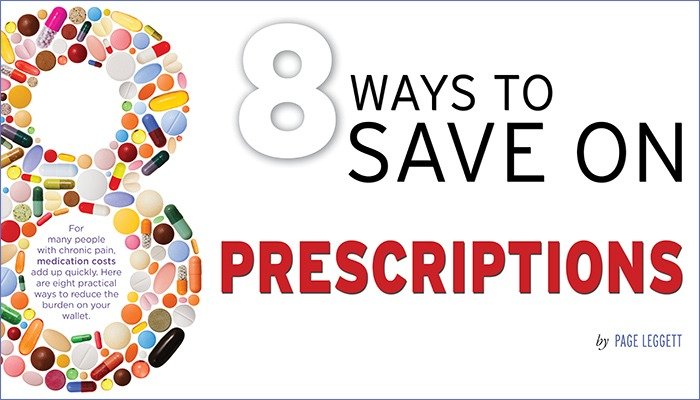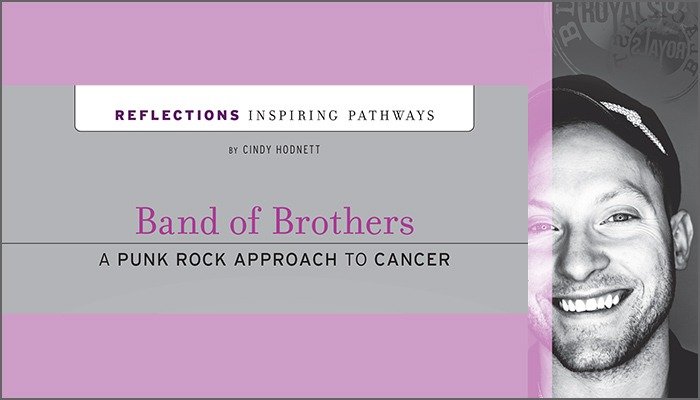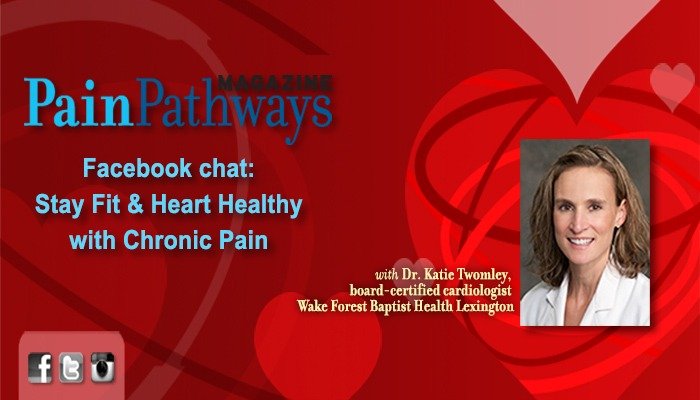8 Ways to Save on Prescriptions

For many people with chronic pain, medication costs add up quickly. Here are eight practical ways to reduce the burden on your wallet.
John recently went on disability because his chronic pain interfered with his ability to work. His limited monthly income makes it challenging for him to pay his bills, especially with the staggering cost of his many prescriptions. Sarah, who also suffers from chronic pain, is able to continue working. She is self-employed and pays for an insurance plan, but it has a high prescription deductible — meaning she has to cover a large portion of her medications on her own.
Cliff, another chronic pain sufferer, has a steady job with good health coverage. However, due to the large number of prescription drugs he takes (many of them at the highest prescription tier), his copayments represent a huge chunk of his monthly budget.
These three examples represent the reality of many Americans. And there are plenty more scenarios in which the high costs of prescriptions create financial challenges. According to Kevin Shute, MD, an anesthesiologist who specializes in pain medicine, people who suffer from chronic pain are particularly likely to get hit in the wallet.
“The majority of the time, people in chronic pain have multiple medical problems,” says Dr. Shute. “They not only have to pay for prescriptions to manage their pain; they also have to buy medications to control high blood pressure, high cholesterol, diabetes or other chronic conditions. And, often, those drugs are equally important to the patient’s overall health.”
Tabitha Orander of Augusta, Georgia, knows this first-hand. She has reflex sympathetic dystrophy syndrome (RSD), fibromyalgia and rheumatoid arthritis. At one time she was taking 20 prescription medications a day just to stay on top of all of her symptoms — especially pain. “I was taking a pretty large concoction every morning,” she says. “I knew I had to reduce that number of medications.”
Dr. Shute points out that pain patients are often likely to be out of work due to their chronic pain. “It’s not only that the average pain patient is medically complicated, but it’s also that a lot of times their income is limited, too,” he says.
Such factors may make a person feel desperate. For instance, if you’re taking a lot of expensive medications, you may have considered not taking one of the more costly ones. Or, it’s possible you considered cutting out other things in your life — such as your home phone service — so that you can afford your prescriptions. Maybe you’ve even started splitting pills to make them last longer.
Fortunately, you don’t have to resort to drastic or unsafe measures to save money. When it comes to prescription medications, there are a number of ways to cut costs. You may even qualify for financial assistance.
EIGHT WAYS TO SAVE ON PRESCRIPTIONS
1.Speak up.
The cost of prescription drugs can be overwhelming, even for those with a steady income, so there’s no shame in admitting you might need advice or help in paying for them. Your doctor can be a good source of information on the subject, but it’s wise to talk to others, too. Anyone from your pharmacist to a support group member can offer valuable money-saving advice. Orander is the leader of a chronic pain support group on Facebook, and she says she frequently finds herself by providing cost-savings tips to other group members. “There are a lot of options out there that people may not be aware of,” she says. “It’s good to seek advice from those in the same boat; you’d be surprised how many tips you’ll get.”
2.Familiarize yourself with your prescription coverage.
You should look through your insurance company’s benefits guide or contact them directly, says Dr. Shute. “It’s very important to be familiar with your particular plan and the types of drugs or dosages it might incentivize,” he says. “Because there are so many different insurance companies and levels of coverage within those companies, your doctor might not be aware of the specific cost-saving options layered into your specific plan.”
One advantage your insurance plan might offer is extended prescriptions, which are usually available at a more affordable rate. “Ninety-day prescription supplies are a great way to drive cost savings,” says Jim Cohn with Walgreens Media Relations. “Most health plans cover this option, particularly for chronic care medications.”
3.Do a little research before selecting a pharmacy — and don’t be afraid to negotiate.
Many people select a pharmacy based on brand loyalty, assuming they’re all basically the same, but pharmacies can vary quite a bit in the prices and discounts they offer. Plus, the advantages can differ depending on a customer’s unique situation, including insurance coverage and drug types. For instance, if your health insurance carrier shares the same parent company with a retail pharmacy chain, you might benefit from that relationship. “If, for example, your prescription coverage is through CVS Caremark, you need to find out if they’ve negotiated a deal for their members to get a discount at CVS pharmacies,” says Dr.Shute.
Often, a pharmacy will offer customers a financial incentive to switch to their pharmacy. For instance, CVS, Rite-Aid and Walgreens pharmacies have all, at various times provided gift cards to new customers.
On the other hand, some pharmacies offer benefits for remaining a customer. Target has a rewards program through which pharmacy customers can earn a 5 percent storewide discount. Meanwhile, Walgreens offers drug price reductions to qualifying members of their savings program. “The Prescription Savings Club offers discounts on more than 8,000 brand-name and generic medications, including more than 700 value-priced generics, which may be available for as low as $1 per week for a 90-day supply,” says Cohn. “It can be used by those who don’t have insurance, or people purchasing a medication that’s either not covered by their plan or whose co-pay is higher than the club price.”
Price checking is another great way to select a pharmacy. Get together a list of your prescriptions and compare it against various pharmacy formularies. Many of the large retail chain pharmacies allow customers to search drug prices on their websites. And don’t forget to look up the prices of generics. Wal-Mart, Target and Kroger all have a $4 list for certain generic drugs.
You should also consider negotiating with pharmacies, says Dr. Shute. “It’s easy to think you’re going to get the best prices at a large chain,” he says, “but in order to get your business, a local pharmacy may be willing to work with you on the cost of your medication.”
Also consider calling a warehouse club pharmacy, even if you’re not a member. Costco, for example, offers very competitive drug prices— which in most states are available to any consumer, regardless of membership status.
4.Contact drug manufacturers.
Most major drug manufacturers offer prescription assistance programs to patients who are facing financial hardships. “One of the things I tell people in my group: ‘If you don’t have any insurance at all, go to the manufacturer of the prescriptions. A lot of times, if you explain your situation, they’ll reduce the drug prices for you,’” says Orander.
A good place to start out is your doctor’s office. Pharmaceutical manufacturers provide informational booklets and application forms for physicians to share with patients during an appointment.“We always try to get patients involved with pharmaceutical company-supported programs when we know there’s a need for financial assistance,” says Dr. Shute. “Most of the larger companies, like Pfizer and Eli Lily, offer them; many smaller manufacturers do as well.”
Once your doctor hands you an application, it’s up to you to fill it out and turns in any supporting financial documents, such as tax statements, to the drug manufacturer.
5.Seek out community resources.
Local programs are another invaluable resource, says Orander. Dr. Shute recommends them as well. “Most areas have nonprofit and government organizations that will help patients manage drug costs,” he says. “They have pharmacy technicians and counselors who volunteer to go over patients’ prescription lists and show them where they can save. This can be especially helpful if you have a long, complicated list of drugs.”
6.If you have Medicaid, invest in a supplemental plan.
You can buy a prescription supplement through a private insurance company. While you will be required to pay a monthly premium, your out-of-pocket prescription costs will be lower. Orander says the plan she selected costs around $60 a month.“There is a cost, but it covers most of my prescriptions,” she says. “Plus, there’s a mail-order component to my plan that allows me to have my medications sent straight to my house.”
To find out more, visit www.medicaid.gov, or contact your local Medicaid office.
7.Consider a more comprehensive pain management approach.
There are effective ways to manage pain that may reduce the need for prescription medications, such as exercise, meditation, relaxation, stress management, and cognitive-behavioral therapy.
“True, comprehensive pain management is a multimodal process,” says Dr. Shute. “Pain management physicians, whether anesthesiologists or neurologists or physiatrists are trained to treat pain with more than just medication. There are several options that can ultimately reduce the need for medication. These can range from knee and back braces to nerve blocks to spinal cord stimulation. Patients can also experience a reduction in pain from working with physical therapists, behavioral therapists, and alternative care providers, such as acupuncturists. There are many options available other than medications.”
8 Reduce symptoms by maintaining a healthy lifestyle.
The fewer symptoms you have, the less medication you’ll need. So don’t underestimate the roles of wellness and effective pain management in reducing your prescription drug costs.
Maintaining a healthy lifestyle can also go a long way toward reducing the need for drugs.“If you’re experiencing joint pain, weight loss can make a huge difference,” explains Dr. Shute.“For every one pound of bodyweight you lose, the pressure on your weight-bearing joints decreases by three pounds. So losing 10 pounds takes 30 pounds of pressure off your knees. That can make a world of difference in pain reduction. Smoking cessation is another important step. There are studies now that show much worse outcomes in chronic pain patients who smoke versus those who don’t. Lifestyle changes can absolutely reduce your pain — and even your need for medication — in some cases.”
Orander says weight loss is one of the most important things she’s done to help her pain. In fact, dietary changes are one of the reasons she’s gone from 20 medications a day to 3. “I watch what I eat and avoid processed and chemically engineered foods,” she says. “By eating better foods and losing weight, I don’t hurt as much. And because I don’t hurt as much, I don’t need to take as many medications. It’s that simple.”
Healthy living not only helps control pain, but it can also improve overall health. “Weight loss and dietary changes have the power to eliminate many disorders, such as diabetes, high blood pressure, and high cholesterol,” says Dr. Shute. “And when those diseases go away, the medications you take for them go away.”
He concludes,“I tell my patients all the time ‘You have more of an ability to make a difference in your health and your chronic pain than I do. For all of my training, the person who can make the biggest difference is you.’” {PP}
PainPathways Magazine
PainPathways is the first, only and ultimate pain magazine. First published in spring 2008, PainPathways is the culmination of the vision of Richard L. Rauck, MD, to provide a shared resource for people living with and caring for others in pain. This quarterly resource not only provides in-depth information on current treatments, therapies and research studies but also connects people who live with pain, both personally and professionally.
View All By PainPathways






